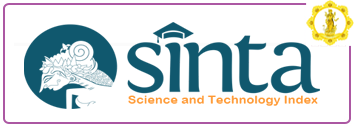Geguritan Kebo Iwa (Kajian Bentuk, Fungsi, dan Pendidikan Karakter)
DOI:
https://doi.org/10.25078/ds.v1i2.528Abstract
The uniqueness of Balinese culture in the form of folklore (satua), should be preserved as an ancestral heritage that contains elements of education, especially in character building. One of the existing folklore is the Kebo Iwa story where its existence is starting to be forgotten. By one of the sons of Bali, the story of Kebo Iwa is presented in the form of geguritan as an educational medium with Hinduism in mind. Geguritan Kebo Iwa was formed by pupuh who were already known to the public, bound by the Padalingsa rules. The work of Mr. I Nyoman Suprapta uses the common Balinese language and the presentation time is short so that the contents and meanings are easy to understand, can provide enlightenment and foster a sense of pride, especially to the younger generation of Bali. The general purpose of research is as an effort to explore, preserve, develop, and describe conceptual values. The specific objectives are to find out the form, explain the function, and understand the value of character education in Geguritan Kebo Iwa. The concepts presented are form, function, and character education, which are guided by structuralism theory, function theory, semiotic theory and value theory. This type of research uses qualitative research. The primary data source is the Geguritan Kebo Iwa manuscript, the secondary data includes books, magazines, and other libraries that are considered relevant, as well as the results of observations, interviews, literature studies and documentation to ensure the truth of the data obtained. Intrinsic elements in Geguritan Kebo Iwa are themes, incidents, plots, characters and characterizations, settings, language styles, and messages. Extrinsic elements are religious, historical, socio-cultural, psychological, and aesthetic elements. The functions of Geguritan Kebo Iwa are recreational, didactic, aesthetic, moral, and religious. The hidden value of education is a summary of the Ministry of National Education's identification, contained in Presidential Decree No. 87 of 2017, including religious, mutual cooperation, independence, nationalism, and integrity.









